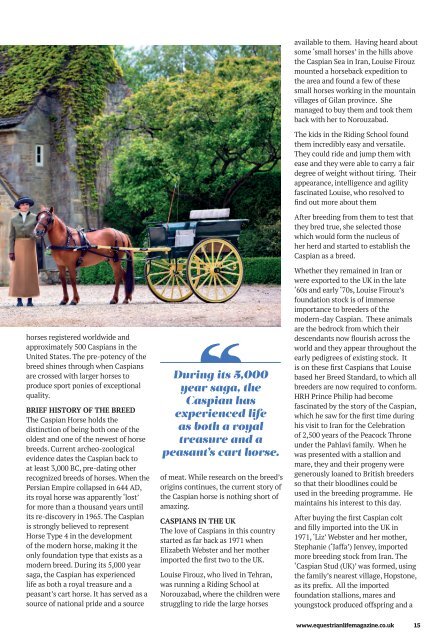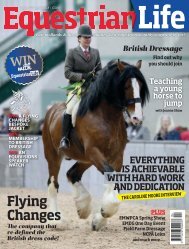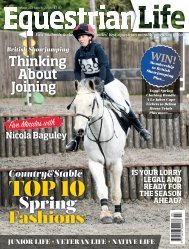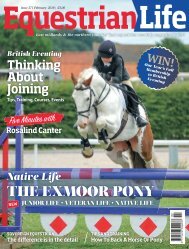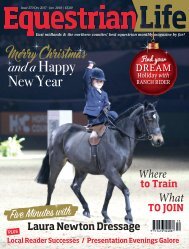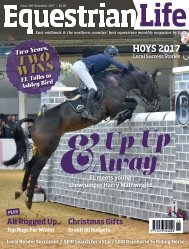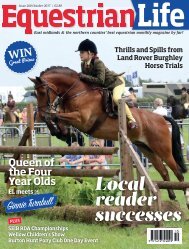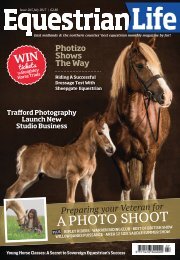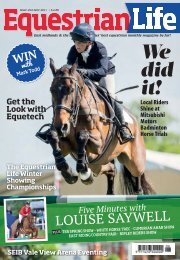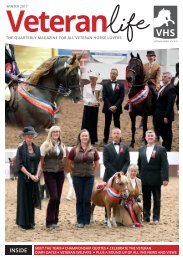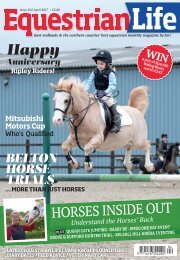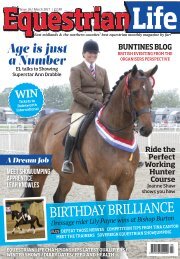Equestrian Life September 2017 Issue
The leading regional monthly for the East Midlands and Yorkshire
The leading regional monthly for the East Midlands and Yorkshire
Create successful ePaper yourself
Turn your PDF publications into a flip-book with our unique Google optimized e-Paper software.
horses registered worldwide and<br />
approximately 500 Caspians in the<br />
United States. The pre-potency of the<br />
breed shines through when Caspians<br />
are crossed with larger horses to<br />
produce sport ponies of exceptional<br />
quality.<br />
BRIEF HISTORY OF THE BREED<br />
The Caspian Horse holds the<br />
distinction of being both one of the<br />
oldest and one of the newest of horse<br />
breeds. Current archeo-zoological<br />
evidence dates the Caspian back to<br />
at least 3,000 BC, pre-dating other<br />
recognized breeds of horses. When the<br />
Persian Empire collapsed in 644 AD,<br />
its royal horse was apparently ‘lost’<br />
for more than a thousand years until<br />
its re-discovery in 1965. The Caspian<br />
is strongly believed to represent<br />
Horse Type 4 in the development<br />
of the modern horse, making it the<br />
only foundation type that exists as a<br />
modern breed. During its 5,000 year<br />
saga, the Caspian has experienced<br />
life as both a royal treasure and a<br />
peasant’s cart horse. It has served as a<br />
source of national pride and a source<br />
During its 5,000<br />
year saga, the<br />
Caspian has<br />
experienced life<br />
as both a royal<br />
treasure and a<br />
peasant’s cart horse.<br />
of meat. While research on the breed’s<br />
origins continues, the current story of<br />
the Caspian horse is nothing short of<br />
amazing.<br />
CASPIANS IN THE UK<br />
The love of Caspians in this country<br />
started as far back as 1971 when<br />
Elizabeth Webster and her mother<br />
imported the first two to the UK.<br />
Louise Firouz, who lived in Tehran,<br />
was running a Riding School at<br />
Norouzabad, where the children were<br />
struggling to ride the large horses<br />
available to them. Having heard about<br />
some ‘small horses’ in the hills above<br />
the Caspian Sea in Iran, Louise Firouz<br />
mounted a horseback expedition to<br />
the area and found a few of these<br />
small horses working in the mountain<br />
villages of Gilan province. She<br />
managed to buy them and took them<br />
back with her to Norouzabad.<br />
The kids in the Riding School found<br />
them incredibly easy and versatile.<br />
They could ride and jump them with<br />
ease and they were able to carry a fair<br />
degree of weight without tiring. Their<br />
appearance, intelligence and agility<br />
fascinated Louise, who resolved to<br />
find out more about them<br />
After breeding from them to test that<br />
they bred true, she selected those<br />
which would form the nucleus of<br />
her herd and started to establish the<br />
Caspian as a breed.<br />
Whether they remained in Iran or<br />
were exported to the UK in the late<br />
‘60s and early ‘70s, Louise Firouz’s<br />
foundation stock is of immense<br />
importance to breeders of the<br />
modern-day Caspian. These animals<br />
are the bedrock from which their<br />
descendants now flourish across the<br />
world and they appear throughout the<br />
early pedigrees of existing stock. It<br />
is on these first Caspians that Louise<br />
based her Breed Standard, to which all<br />
breeders are now required to conform.<br />
HRH Prince Philip had become<br />
fascinated by the story of the Caspian,<br />
which he saw for the first time during<br />
his visit to Iran for the Celebration<br />
of 2,500 years of the Peacock Throne<br />
under the Pahlavi family. When he<br />
was presented with a stallion and<br />
mare, they and their progeny were<br />
generously loaned to British breeders<br />
so that their bloodlines could be<br />
used in the breeding programme. He<br />
maintains his interest to this day.<br />
After buying the first Caspian colt<br />
and filly imported into the UK in<br />
1971, ‘Liz’ Webster and her mother,<br />
Stephanie (‘Jaffa’) Jenvey, imported<br />
more breeding stock from Iran. The<br />
‘Caspian Stud (UK)’ was formed, using<br />
the family’s nearest village, Hopstone,<br />
as its prefix. All the imported<br />
foundation stallions, mares and<br />
youngstock produced offspring and a<br />
www.equestrianlifemagazine.co.uk 15


